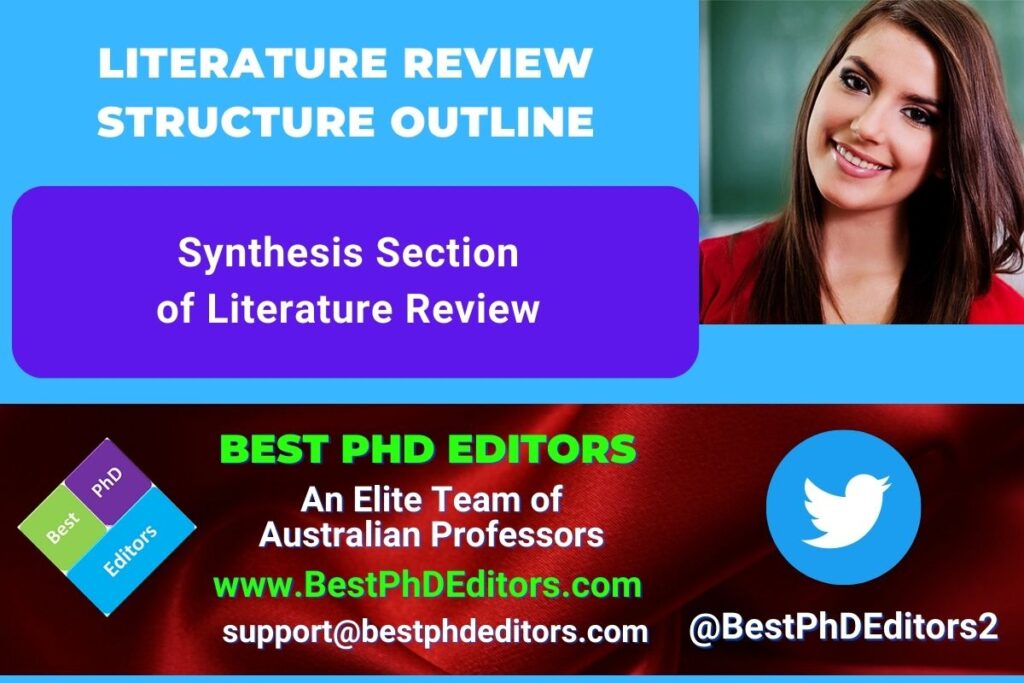
Structuring a Literature Review for a PhD Thesis: Learn with Examples
A literature review is a crucial component of a PhD thesis, as it provides an overview of the existing research in your field and demonstrates the gap in knowledge that your research aims to fill. A well-structured literature review is important for ensuring the validity and reliability of your research and for demonstrating your expertise in the field. This tutorial will provide guidance for PhD students at Australian and UK universities on how to structure their literature review for their thesis.

Step 1 of Structuring a Literature Review: Defining the Purpose of Your Literature Review
The first step in structuring a literature review is to define the purpose of your review. Your purpose should guide the selection of literature and the structure of your review. For example, if your purpose is to provide an overview of the existing research on a specific topic, your review might focus on the findings of previous studies and their contribution to the field. If your purpose is to identify gaps in knowledge, your review might focus on areas where further research is needed.
Step 2 of Structuring a Literature Review: Identifying Relevant Literature
Once you have defined the purpose of your literature review, the next step is to identify the relevant literature. This involves conducting a comprehensive and thorough literature search, using keywords related to your research question, academic databases, journals, books, and reports. Some commonly used databases for literature searches include JSTOR, Google Scholar, and Web of Science.


Step 3 of Structuring a Literature Review: Organizing the Literature
After collecting a sufficient amount of literature, the next step is to organize the literature. This involves grouping similar studies together based on their findings, methods, and contributions to the field. For example, if your research question focuses on the use of technology in the classroom, you might categorize studies based on the type of technology used (e.g. laptops, tablets, etc.), the age group of students, and the type of educational setting. This will help you see trends and identify key themes that will inform your research proposal.
Step 4 of Structuring a Literature Review: Outlining the Structure of Your Review
The next step in structuring your literature review is to outline the structure of your review. A common structure for a literature review includes the following:


Introduction Section of Literature Review
The introduction of your literature review should provide the background information on your research question and the purpose of your literature review. Start by briefly introducing your research topic and the questions you aim to answer. This will help set the context for your literature review and help your reader understand why you chose to conduct a literature review on this topic.
It’s also important to provide a clear and concise explanation of the purpose of your literature review. Explain why you are reviewing the existing research, what you hope to gain from your review, and how it will contribute to the advancement of knowledge in your field.
Background Section of Literature Review
In the background section, provide a brief overview of the existing research in your field and the context for your research. This section should provide a broad understanding of the key studies, theories, and debates relevant to your research question.
Begin by providing a general overview of the field and its history. You can also include a timeline of key events or breakthroughs in the field that have led to the current state of research. This will help you establish the context for your research and help your reader understand why your research is important.


Themes and Sub-Themes Section of Literature Review
The themes and sub-themes section is where you group similar studies together and identify key themes and sub-themes based on their findings, methods, and contributions to the field. This section should be organized logically and have a clear flow, making it easy for your reader to understand and follow.
Start by identifying the common themes that emerge from the studies you have reviewed. These themes should be related to your research question and should be based on the key findings of the studies you have reviewed. Once you have identified the common themes, you can then group similar studies together and organize them into sub-themes.
It’s important to provide a clear and concise explanation of each theme and sub-theme, including the key findings and contributions of each study. You can also highlight the similarities and differences between the studies to provide a clearer understanding of the existing research in your field.
Synthesis Section of Literature Review
In the synthesis section, summarize the findings of the studies you’ve reviewed and identify the strengths and limitations of the existing research. This section should provide a clear and concise summary of the existing research, highlighting the key findings and contributions of each study.
Start by summarizing the findings of each theme and sub-theme, focusing on the key contributions and limitations of the existing research. This will help you identify the overall strengths and weaknesses of the existing research and provide a clearer understanding of the current state of research in your field.
It’s also important to critically evaluate the existing research, highlighting the limitations and weaknesses of each study. This will help you identify areas for improvement and help you justify your own research, highlighting why your research is needed and how it will contribute to the advancement of knowledge in your field.


Gaps in Knowledge Section of Literature Review
In the gaps in knowledge section, identify areas where further research is needed and provide context for your own research. This section should highlight the key areas where there is a lack of research and provide a clear justification for why your research is needed.
Start by identifying the key gaps in knowledge in your field and explaining why these gaps need to be filled. You can also provide a brief overview of the current state of research in these areas, highlighting the key limitations and weaknesses of the existing research.
It’s important to clearly articulate why your research is needed, explaining how it will contribute to the advancement of knowledge in your field. This will help you justify your own research and provide a clear understanding of its significance and impact.
Conclusion Section of Literature Review
The conclusion of your literature review should provide a summary of your literature review and its contribution to your field. This section should bring together the key findings from your review and provide a clear understanding of how your literature review has contributed to the advancement of knowledge in your field.
Start by summarizing the key findings of your literature review, highlighting the strengths and limitations of the existing research. You can also provide an overview of the key themes and sub-themes you identified and explain how they contribute to the overall understanding of your research question.
It’s important to emphasize the contribution of your literature review to the advancement of knowledge in your field. Explain how your review has filled gaps in knowledge, provided new insights, and identified areas for further research. This will help you demonstrate the significance of your literature review and its contribution to the field.
Finally, provide a clear and concise summary of your literature review and its contribution to your field. This section should provide a final summary of the key findings, themes, and contributions of your review and emphasize the overall significance of your research.


Step 5 of Structuring a Literature Review: Writing the Literature Review
The final step in structuring your literature review is to write the review. When writing your review, it is important to be concise, clear, and logical in your presentation of the literature. Some tips for writing a literature review include:
- Using headings and subheadings to structure your review and make it easier to read
- Including in-text citations and a reference list to acknowledge the sources of your information
- Being critical and evaluating the quality of the studies you’ve reviewed
- Using quotes sparingly and summarizing the findings of the studies in your own words
While focusing on structuring your literature review, our articles on literary reviews and literature review examples also provide an in-depth understanding to the PhD students.
Properly structuring your literature review is key to a successful PhD thesis. If you need premium support, check out our PhD Literature Review Writing Services and Dissertation Methodology Writing Services offered by our esteemed Australian professors.
In conclusion, structuring your literature review is a critical step in conducting a comprehensive and effective review. A well-structured review will provide a clear and concise understanding of the existing research in your field and its contribution to the advancement of knowledge. By following these guidelines and examples, you can structure your literature review in a way that is clear, logical, and effective, contributing to the advancement of knowledge in your field.
Guidance for PhD Students
How to Write a Successful PhD Proposal for Australian Universities: Learn with Examples
Writing a Successful PhD Proposal for UK Universities: Tips and Examples
PhD Proposal Examples: Uncovering the Secrets to a Winning Proposal
NVIVO: A Step-by-Step Guide to The Data Analysis Software
NVIVO Coding: A Step-by-Step Tutorial
9 Easy Examples of Qualitative Data in Research
Dissertation Methodology Examples for PhD: Methodology Writing Made Easy
Dissertation Methodology Writing Decoded: Learn the Steps with Easy Examples
Binary Logistic Regression in SPSS: Learn the Steps with Easy Examples
Multiple Linear Regression using SPSS: Learn with Easy Examples





Pingback: Literature Review Example: The Correct Way To Write And Structure The Literature Review For Your PhD Thesis